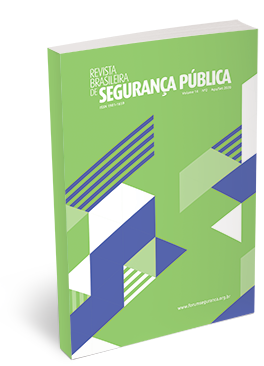Safety Measure
profile of patients admitted in a psychiatric hospital interior of São Paulo state
DOI:
https://doi.org/10.31060/rbsp.2020.v14.n2.1060Keywords:
Mental disorders, Safety measures, Psychiatric hospitalizationsAbstract
Profile of Persons with Mental Disorders Authors of Crimes Insured in a Psychiatric Hospital of the Interior of São Paulo In the Brazilian criminal justice system, people who practice behaviors defined as crimes and have your understanding capacity of reality reduced due to mental disorders are classified as not imputable from punishment for which there is not worth it. Therefore, the individual is acquitted and submitted to the security measure, a measure of predominantly preventive character, which is based on the term dangerousness and not on the culpability of the agent. Within this context, this descriptive documentary research, which seeks, through the analysis of medical records, to understand who are the individuals hospitalized as a result of security measures in a public psychiatric hospital located in the Municipality of Ribeirão Preto. Among the results that have attracted attention are the prevalence, among the internees, of diagnoses of use of substances that cause addiction, the large number of disinternations without the performance of a report of dangerousness, as well as the predominance of individuals with low income and educational level. In this way the results point to the existence of problems that go beyond the knowledge produced by the health sciences or law, and the challenge of joining efforts among the different sectors in search of public policies that can guarantee that a more humanized assistance to people with mental disorders that have committed some kind of crime.
Downloads
References
BARROS, S.; OLIVEIRA, M. A. F.; ARANHA, A. L. A. Práticas inovadoras para o cuidado em saúde. revista da Escola de Enfermagem da USP, v. 41, p. 815-819, 2007.
BITENCOURT, C. R. tratado de direito Penal: Parte Geral 1. 19. ed. rev. ampl. e atual. São Paulo: Saraiva, 2013.
BRASIL. Ministério da Saúde. Portaria 94, de 14 de janeiro de 2014. Institui o serviço de avaliação e acompanhamento de medidas terapêuticas aplicáveis à pessoa com transtorno mental em conflito com a lei, no âmbito do Sistema Único de Saúde (SUS). Brasília, DF: MS, 2014.
BRASIL. Código Penal do Brasil. 50a ed. São Paulo: Saraiva, 2012.
CAPEZ, F. Curso de Direito Penal: parte geral. 22 ed. São Paulo: Saraiva, 2018. CNJ. Conselho Nacional de Justiça. Recomendação nº 35, de 12 de julho de 2011. Dispõe sobre as diretrizes a serem adotadas em atenção aos pacientes judiciários e à execução da medida de segurança. Brasília, DF: CNJ, 2011.
CORDIOLI, Maria Sirene; BORENSTEIN, Miriam Süsskind; RIBEIRO, Anesilda Alves de Almeida. Hospital de custódia: os direitos preconizados pela reforma psiquiátrica e a realidade dos internos. escola anna Nery Revista de Enfermagem, v. 10, n. 4, p. 671-677, 2006.
CORREIA, L. C.; LIMA, I. M. S. O.; ALVES, V. S. Direitos das pessoas com transtorno mental autoras de delitos. Cad. de Saúde Pública, v. 23, n. 9, p. 1995-2002, set. 2007.
DINIZ, D. A custódia e o tratamento psiquiátrico no Brasil: censo 2011. Brasília: Editora da UnB, 2013.DINIZ, Débora; BRITO, Luciana. “Eu não sou presa de juízo, não”: Zefinha, a louca perigosa mais antiga do Brasil. História, Ciências, Saúde – Manguinhos, v. 23, n. 1, p.113-129, jan.-mar. 2016. DOI: http://dx.doi.org/10.1590/S0104-59702016000100008.
DOUGLAS, K. S.; OGLOFF, J. R.; HART, S. D. Evaluation of a model of violence risk assessment among forensic psychiatric patients. Psychiatric services, v. 54, n. 10, p. 1372-1379, oct. 2003.
DREW, N. et al. Human rights violations of people with mental and psychosocial disabilities: an unresolved global crisis. Lancet, v. 378, p. 1664-75, 2011.
DUNCAN, C.; JONES, K.; MOON, G. Context, composition and heterogeneity: using multilevel models in health research. Soc Sci Med., v. 46, n. 1, p. 97-117, 1998.
FOUCAULT, M. A verdade e as formas jurídicas. Rio de Janeiro: NAU, 2005.
GARBAYO, J.; ARGÔLO, M. J. R. Crime e doença psiquiátrica: perfil da população de um hospital de custódia no Rio de Janeiro. Jornal Brasileiro de Psiquiatria, v. 57, n. 4, p. 247-252, 2008.
JACOBINA, P. V. Direito penal da loucura: medida de segurança e reforma psiquiátrica. revista de Direito Sanitário, v. 5, n. 1, p. 67-85, 2004.
KONRAD, N.; LAU, S. Dealing with the mentally ill in the criminal justice system in Germany. int J law Psychiatry, v. 33, n. 4, p. 236-240, set/out. 2010.
MELNYCHUK, R. M.; VERDUN-JONES, S. N.; BRINK, J. Geographic risk management: A spatial study of mentally disordered offenders discharged from forensic psychiatric care. International Journal of forensic Mental Health, v. 8, n. 3, p. 148-168, 2009.
PERES, M. F. T.; NERY FILHO, A. A doença mental no direito penal brasileiro: inimputabilidade, irresponsabilidade, periculosidade e medida de segurança. História, Ciências, Saúde – Manguinhos, v. 9, n. 2, p. 335-55, 2002.
SIEGEL, A. W. Inequality, privacy, and mental health. International Journal of Law and Psychiatry, v. 31, n. 2, p. 150–157, 2008. STF. Supremo Tribunal Federal. Habeas Corpus 98.360. Medida de Segurança e sua natureza punitiva. Duração máxima de 30 anos, 2009.
WHO. WORLD HEALTH ORGANIZATION. Mental Health and development: Targeting people with mental health conditions as a vulnerable group. Geneva: WHO, 2010.
Downloads
Published
How to Cite
Issue
Section
License
Copyright (c) 2020 Revista Brasileira de Segurança Pública

This work is licensed under a Creative Commons Attribution 4.0 International License.
Licensing
The Brazilian Journal of Public Security uses the Creative Commons License as a form of licensing for its published works. The license used follows the CC BY 4.0 - Attribution 4.0 International model.
To see the permitted rights please go to the full licence or to our Copyright and Licensing page.



